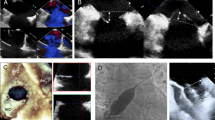Abstract
Background
Transseptal puncture (TSP) is the first step in pulmonary vein isolation and catheter ablation, as well as in left atrial appendage closure in atrial fibrillation. Although TSP has been reported to be successful in patients with device closure of interatrial septal communications, questions pertinent to its feasibility in patients with large devices still remain. We sought to determine whether a “safe zone” for TSP could be visualised by computer tomography (CT), especially if larger device sizes for interatrial septal communication closure (IASC-C) had been used.
Methods
Retrospective observational study of 20 patients who underwent CT for de novo chest pain occurring after IASC-C or as a diagnostic test for suspected or proven coronary artery disease (CAD). Clinical follow-up was for 20.5 ± 17.6 (6–84) months. CT was done18 ± 10 (2–28) weeks after IASC-C. Device size and dimensions of both atria in the long and short axes were measured, as was the minimal distance of the device edge to the inferior and inferoposterior atrial floor.
Results
The calculated minimal distance from the device edge to the inferior aspect (at 6 o’clock) of the (right or left) atrial floor was 7.2 ± 6.5 (0–27) mm while that to the inferoposterior aspect (at 07:30 o’clock) was 5.3 ± 4.2 (0–15) mm. In both locations, a distance of >6 mm was documented in ten patients (50%) while in nine patients (45%) a space of <6 mm was shown in both locations. There was no correlation between atrial dimensions or device size and minimal device distance to either wall.
Conclusion
With the exception of cases with the smallest devices (18 and 20 mm), neither device size nor atrial dimensions allow us to predict the feasibility of TSP in patients with a clamshell-type interatrial septal device in place, so that CT may be of help in determining whether a safe puncture space does exist in these patients.



Similar content being viewed by others
References
Camm, J. A., Kirchhof, P., Lip, G. Y. H., Schotten, U., Savelieva. I., Ernst S, et al. (2011). Guidelines for the management of atrial fibrillation. The task force for the management of atrial fibrillation of the European Society of Cardiology (ESC) of the European Society of Cardiology. European Heart Journal (in press).
Weerasooriya, R., Khairy, P., Litalien, J., Macle, L., Hocini, M., Sacher, F., et al. (2011). Catheter ablation for atrial fibrillation. Journal of the American College of Cardiology, 57, 160–166.
Wagdi, Ph. (2010). Incidence and predictors of atrial fibrillation following transcatheter closure of interatrial septal communications using contemporary devices. Clinical Research in Cardiology, 99, 507–511.
Zaker-Shahrak, R., Fuhrer, J., & Meier, B. (2008). Transseptal puncture for catheter ablation of atrial fibrillation after device closure of patent foramen ovale. Catheterization and Cardiovascular Interventions, 71, 551–552.
Holmes, D. R., Reddy, V. Y., Turi, Z. G., Doshi, S. K., Sievert, H., Buchbinder, M., et al. (2009). Percutaneous closure of the left atrial appendage versus warfarin therapy for prevention of stroke in patients with atrial fibrillation: a randomised non-inferiority trial. Lancet, 374, 534–542.
Wagdi, Ph. (2011). Interatrial septal communication closure: adverse events and lessons learned. Cardiology Research, 2, 7–15.
Wagdi, Ph., & Alkadhi, H. (2010). The impact of cardiac CT on the appropriate utilization of catheter coronary angiography. International Journal of Cardiovascular Imaging 26(3):333–344.
Feigenbaum, H., Armstrong, W. F., & Ryan T. (2005). Echocardiography, 6th edition. Baltimore: Lippincot Williams and Wilkins, pp 184–195.
Wagdi, Ph., & Siebenmann, R. (2011). Unkonventionelle Hybrid-Intervention bei etabliertem Vorhofflimmern: optimierte Behandlung durch interdisziplinäre Zusammenarbeit. Kardiovaskuläre Medizin 14, 159–162.
Acknowledgements
This work is dedicated to C. Rupp.
Author information
Authors and Affiliations
Corresponding author
Rights and permissions
About this article
Cite this article
Wagdi, P., Alkadhi, H. Can computer tomography help predict feasibility of transseptal puncture after percutaneous closure of an interatrial septal communication?. J Interv Card Electrophysiol 34, 167–172 (2012). https://doi.org/10.1007/s10840-011-9625-6
Received:
Accepted:
Published:
Issue Date:
DOI: https://doi.org/10.1007/s10840-011-9625-6




